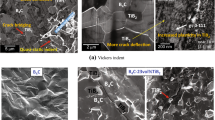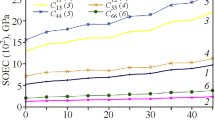Abstract
Elasticity moduli and elastic constants for sphaleritic and wurtzitic boron nitride are calculated and determined by experiment. Numerical values are given for single crystals of these materials and polycrystals of hexanite-R, elbor-R, belbor, kiborite, and other superhard materials. An approach is suggested for combining hot pressing at ultrahigh pressures and a pulsed ultrasonic technique which may be used to determine the elasticity modulus and elastic constants of the majority of refractory compounds which are difficult to determine by other techniques.
Similar content being viewed by others
References
I. N. Frantsevich (ed.), Hexanite and Hexanite-R and Articles Based on Them for Tool Purposes [in Russian], ONTI Inst. Probl. Materialovedeniya, Akad. Nauk UkrSSR, Kiev (1974).
I. N. Frantsevich (ed.), Superhard Materials, Naukova Dumka, Kiev (1980).
A. V. Kurdyumov and A. N. Pilyankevich, Phase Transformations in Carbon and Boron Nitride [in Russian], Naukova Dumka, Kiev (1979).
P. V. Zakharenko, V. M. Volkogon, A. V. Bochko, et al., Production Features of Machining with a Tool Made of Polycrystalline Superhard Materials [in Russian], Naukova Dumka, Kiev (1991).
A. B. Lyashchenko, P. I. Mel'nichuk, and I. N. Frantsevich, “Normal elasticity modulus for some refractory compounds,” Poroshk. Metal., No. 5, 10 (1961).
I. N. Frantsevich, E. A. Zhurakovskii, and A. B. Lyashchenko, ”Elastic constants and features of the electron structure of some classes of refractory compounds prepared as cermets,” Neorgan. Materialy.,3, No. 1, 8–15 (1967).
L. F. Vereshchagin, Synthetic Diamonds and Hydroextrusion [in Russian], Nauka, Moscow (1982).
W. Voigt, Lehbuch der Kristallphysic, Springer, Leipzig (1958).
A. Reuss, “Berechnung der Fliesgrenze von Mischkristallen auf Grund der Plastizatsberechnung fur Einkristalle,” Z. Angew. Math. und Mech.,9, No. 1, 49–58 (1929).
R. Hill, “The elastic behavior of crystalline aggregate,” Proc. Phys. Soc. A., No. 65, 349–354 (1952).
O. Anderson, “Determination and some applications of isotropic elastic constants for polycrystalline systems obtained from data for single crystals,” in: Physical Acoustics, Vol. 3 [Russian translation], Mir, Moscow (1968), pp. 62–121.
M. Born and Khuan Kun', Dynamic Theory of Crystal Lattices [in Russian], Izd. Inostr. Lit., Moscow (1958).
B. A. Glagolevskii and I. B. Moskovenko, Frequency Acoustic Methods for Monitoring in Engineering [in Russian], Mashinostroenie, Leningrad (1977).
O. I. Zaporozherts, “Ultrasonic velocity in SbSn in the critical range,” Fiz. Tverdogo Tela,17, No. 12, 3672–3674 (1975).
O. I. Zaporozhets and L. V. Tikhonov, “Ultrasonic studies of residual stresses in chromium after thermal cycling treatment,” Metallofizika,7, No. 5, 119–120 (1985).
O. I. Zaporozhets, N. A. Krapivka, and L. V. Tikhonov, “Effect of prior thermal cycling treatment on ultrasonic anomalies in chromium in the Néel temperature range,” Fiz. Metal. Metallovedenie,61, No. 2, 379–384 (1986).
H. T. McScimin and W. L. Bond, “Elastic moduli of diamond,” Phys. Rev.,105, No. 3, 116–121 (1957).
L. A. Shul'man, “Debye temperatures for lonsdaleite and wurtzitic modification of boron nitride,” Sverkh. Mat., No. 4, 30–33 (1984).
V. A. Pesin, “Elastic constants for dense modifications of boron nitride,” Sverkh. Mat., No. 6, 18–21 (1980).
T. D. Sokolovskii, “Phonon spectrum of cubic boron nitride,” Izv., Akad. Nauk SSSR, Neorg. Mat.,19, No. 9, 1484 (1983).
S. A. Klimenko and Yu. A. Mukovoz, “Polycrystalline superhard materials based on boron nitride and their application in a cutting tool,” Mir Instrumenta, No. 1, 26–29 (1995).
Additional information
Institute of Materials Science, Ukrainian Academy of Sciences, Kiev. Institute of Metal Physics, Ukrainian Academy of Sciences, Kiev. Translated from Poroshkovaya Metallurgiya, Nos. 7/8(380), pp. 92–99, July–August, 1995.
Rights and permissions
About this article
Cite this article
Bochko, A.V., Zaporozhets, O.I. Elastic constants and elasticity moduli of cubic and wurtzitic boron nitride. Powder Metall Met Ceram 34, 417–423 (1996). https://doi.org/10.1007/BF00559434
Issue Date:
DOI: https://doi.org/10.1007/BF00559434




